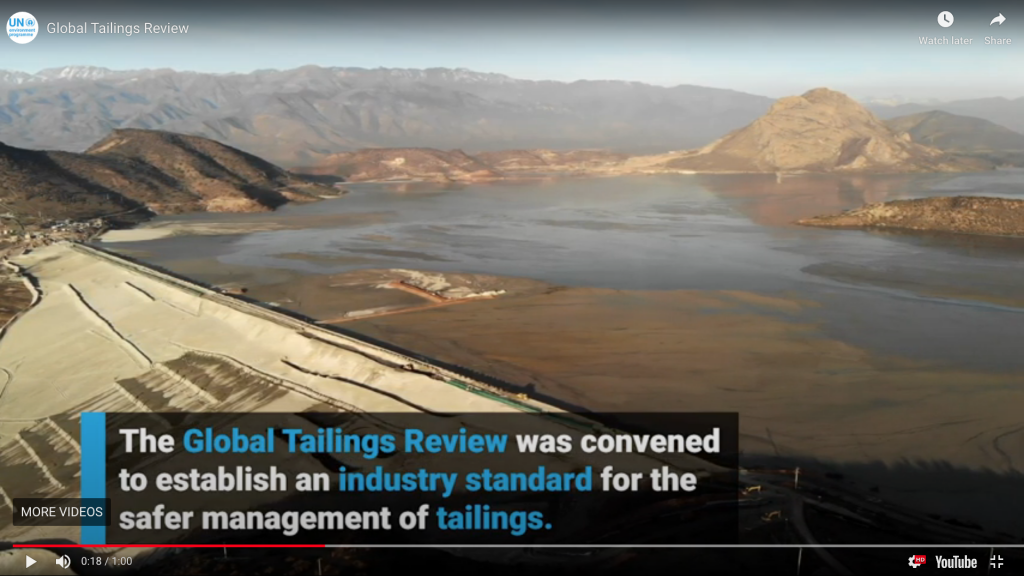[caption id="attachment_1003740844" align="alignnone" width="550"]

Screen shot from a Global Tailings Review on the new Global Industry Standard on Tailings Management. Credit: Global Tailings Review[/caption]
The Global Tailings Review (GTR) has released the first ever
Global Industry Standard on Tailings Management, aimed at strengthening current best practices around tailings dams in the mining sector, with the goal of zero harm to people and the environment.
The standard is the result of a more than one-year process started by the United Nations Environment Programme, Principles for Responsible Investment (PRI) and the International Council on Metals and Mining (ICMM) last March.
The guidelines, organized around six topic areas, 15 principles and 77 auditable requirements, add new requirements for independent oversight of tailings facilities design and management. They also outline expectations for more disclosure to the public about tailings facilities, including information about the potential consequences of a failure.
Intended to provide a framework for safe tailings facility management, the standard allows operators flexibility in how to achieve that. For example, it does not prohibit the use of upstream dams, such as the one at Vale's Feijao mine in Brazil, whose failure in January 2019 killed at least 259 people, and which served as the impetus behind the creation of the standard.
“The catastrophic dam collapse at Vale’s Corrego de Feijao mine in Brumadinho was a human and environmental tragedy that demanded decisive and appropriate action to enhance the safety and strengthen the governance of tailings facilities across the globe,” said Dr Bruno Oberle, chair of the Global Tailings Review, in a release. “I am particularly pleased to deliver a document which reflects and addresses the complexity and multi-disciplinary nature of sound tailings management.”
The standard applies to existing and future tailings facilities, and covers the entire life cycle from site selection through closure. The GTR notes that mine operators must have "zero tolerance for human fatalities and strive for zero harm to people and the environment from the earliest phases of project conception.” It also noted that to be compliant with the standard, operators must use "specified measures to prevent the catastrophic failure of tailings facilities and to implement best practices in planning, design, construction, operation, maintenance, monitoring, closure and post closure activities.”
The review was supported by a multi-disciplinary expert panel, with input from a multi-stakeholder advisory group. It also involved extensive public consultations with communities, government representatives, investors, multilateral organizations and mining industry stakeholders.
Speaking for the PRI, which represents US$103.4 trillion in assets under management, Adam Matthews, director of ethics and engagement on the investment team for the Church of England Pensions Board, said that people have been calling for a global standard to drive best practice in tailings management for decades.
“It is tragic it has taken the Brumadinho disaster to make this happen, but a unique partnership has come together to address a systemic challenge faced by the mining sector and we are now as committed to make this common practice in all operations," Matthews said. "For the first time, we have a global standard that goes beyond existing best practice and establishes the most comprehensive standard that investors will hold companies accountable for in their implementation.”
Matthews added that he looks forward to working with all parties to establish an independent entity to oversee the implementation of the standard.
While the standard is voluntary, ICMM members – which include Vale, and which represent about a third of the global mining industry – will be required to implement the standard.
"The standard will be integrated into ICMM’s existing member commitments, which includes third-party assurance and validation, and we are in the process of developing supporting guidance,” said Tom Butler, CEO of ICMM. “Members have committed that all facilities with ‘Extreme’ or ‘Very high’ potential consequences will be in conformance with the standard within three years of today, and all other facilities within five years."
NGOs such as London Mining Network don't believe the standard goes far enough and would like to see an independent international tailings dams monitoring body formed, and legally enforceable penalties for non-compliance.
It also points to guidelines released in June and developed by a group of NGOs, community groups and scientists,
Safety First: Guidelines for Responsible Mine Tailings Management. The group says the new standard fails to meet 15 of the 16 guidelines set out in that report, which called for banning upstream dams, prohibiting new tailings facilities from being built immediately upstream from communities, and mandating the use of best available technology, such as filtered tailings.

Comments